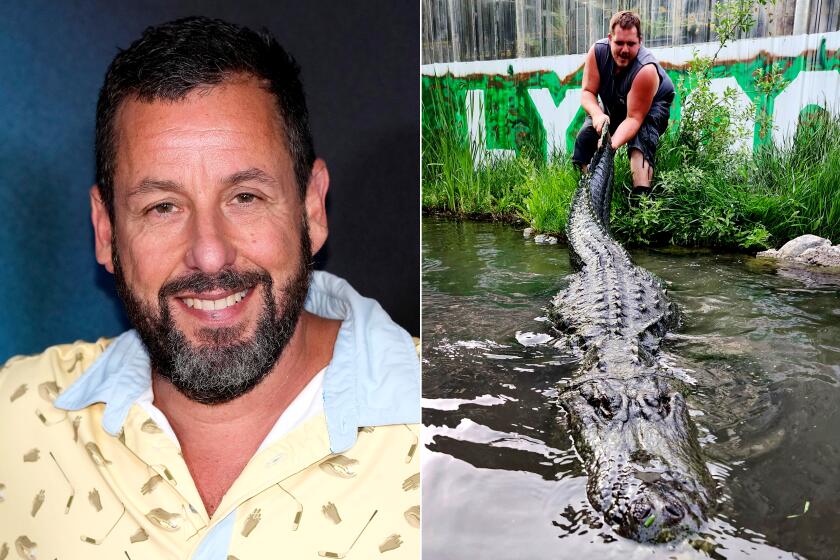A Director of Intuition, Right to His Final Scene
- Share via
The filmmaker John Frankenheimer, who died Saturday from a massive stroke at the age of 72, was an extraordinary man to have lunch with. We met weekly at an Italian restaurant in the Hollywood Hills for nearly three years while I recorded an oral history with him for the Directors Guild of America. We never remembered to stop the tape while the waiter took our orders, so the faithful transcript records our week-to-week preferences between the penne and the angel hair, the penne usually winning.
John used to say that the first line of his obituary was sure to label him the director of “The Manchurian Candidate.” The papers are proving him a prophet, because “The Manchurian Candidate” is a masterpiece, still as tense and surprising to watch as it was when it was made 40 years ago. The film was one of those superb coming-together of ingredients that add up to magic: Angela Lansbury cast wildly against type as the coldly murderous mother; a model script by George Axelrod and Richard Condon; a remarkable performance from Frank Sinatra. John, an actor himself in his collegiate days, drew out of Sinatra one of his best dramatic performances.
Frankenheimer had many such gifts as a filmmaker. No one did crowd scenes, riots or tumults better. He made them comprehensible and always integral to the story. On the set he could be a demanding taskmaster. That came of being a perfectionist.
John loved to talk about his early days in live television more than a half-century ago. It was a perfect time to learn the craft. The facilities were rudimentary by today’s standards--there was not yet any videotape--but the material was often the best. It was rich with literary classics, used because so much of the material was already in the public domain.
One of John’s favorite stories involved Hemingway’s “The Snows of Kilimanjaro.” Robert Ryan played the hunter in Africa dying of gangrene, unable to seek help because the Land Rover had broken down. The prop man produced a shiny, brand-new vehicle for use in the scene; John said he needed a battered and rusted Land Rover, not one that looked as if it could drive away. The prop man was adamant that the new vehicle was all John was going to get. So John and his crew aged the vehicle--with sledgehammers. Every stroke was a blow against bureaucracy, he told me years later.
The lessons of improvised ingenuity served John well. Sitting in the editing room during “Grand Prix,” John saw that they had photographed crowds at the races on two different days, once in sunny weather, once during a light rain. The footages wouldn’t match. John went to the so-called insert camera, took off his wristwatch and photographed it close-up while he dribbled some of his gin and tonic on its face. At least one critic applauded the clever transition from dry to wet weather.
During the live TV days, John was doing a historical drama starring the fine British actor Sir Cedric Hardwicke. The actor protested he could not memorize a long monologue in one of his scenes. John assured him he would be fine. But during the scene Hardwicke’s voice stopped although his lips kept moving. From the control room John quickly realized what Hardwicke was doing.
John killed the microphone on the stage and fed Sir Cedric the blown lines on the intercom. Hardwicke’s voice resumed as if nothing had happened.
When Sir John Gielgud was doing “The Browning Version” for Frankenheimer on Playhouse 90, he asked for a pair of granny glasses as a prop. At the first bare-stage rehearsal Frankenheimer was amazed to see that Gielgud had shed a tear on the glasses. It was a wonderful touch but John was dismayed that it might not happen again. But it did, at two more rehearsals, the dress rehearsal and finally during the live broadcast. “How can you produce that tear again and again like that?” John asked Gielgud.
“Oh, I just think of Mummy and it all comes out,” Gielgud said.
The last time John and I had lunch he arrived in a glorious convertible that Mercedes-Benz had custom designed for, I think, the Sultan of Brunei, who decided he didn’t like it and refused to pay for it. John did. He had been a race-car driver in his college days at Williams and had become a collector. He told me that he had once been jailed in Kansas during production of “Gypsy Moths.” He had been clocked driving 190 miles an hour.
John had more vitality than almost anyone I’ve ever known. That was part of the pleasure of his company. He was also a marvelous raconteur with hundreds of anecdotes, sometimes salty, from a half-century of life in film and television. Until just before his last major surgery he played tennis--hard, competitive tennis--every morning. He was a fine cook and our luncheon discussions with the patrone suggested one chef talking to another.
He was a constant reader, always eager to hear about and discuss new books. At 6 feet, 4 inches, he could have been a double for John Wayne. Without meaning to, he commanded attention when he entered a room. He embraced life as a man half his age might.
After his stroke very early Saturday morning his mind remained sharp and clear. But to those with him it was evident that he knew his days of vigor and creativity were over. He said goodbye with a peaceful resignation. It was as if he had directed the scene as he had directed so many scenes for so many years.
More to Read
Only good movies
Get the Indie Focus newsletter, Mark Olsen's weekly guide to the world of cinema.
You may occasionally receive promotional content from the Los Angeles Times.










